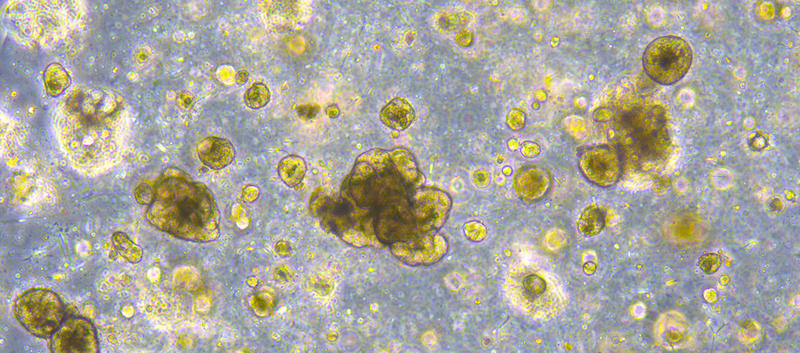20 year-old mystery of malaria vaccine target solved
The human piece of a malaria infection puzzle has been revealed for the first time, solving a long-standing mystery. A protein displayed on the surface of malaria parasites called “TRAP” is a high-priority vaccine target, but how it interacts with human host cells has remained a puzzle. Scientists from the Wellcome Sanger Institute have discovered a receptor protein on the surface of human cells that the TRAP protein interacts with as it navigates through the body.
The results, published today (9 April) in PNAS could help improve the development of an effective malaria vaccine.
Nearly half of the world’s population is at risk of malaria and more than 200 million people are infected each year. The disease caused the deaths of almost half a million people globally in 2015*.
Malaria is caused by Plasmodium parasites that are transmitted to people through the bites of infected mosquitoes. Once the parasites have migrated from the mosquito bite site in the human skin, they must then navigate their way to a blood vessel and through the blood stream before finally infecting the liver for the next stage of the lifecycle. However, the molecular cues between the parasites and human host cells which direct this migration have remained unclear, making it challenging to intervene and stop the parasites in their tracks.
In this study, scientists from the Wellcome Sanger Institute have shown for the first time that the malaria parasite surface protein, TRAP, interacts directly with proteins called integrins on the surface of human cells.
“For the first time, we’ve found a human receptor for the high-priority malaria vaccine target, TRAP. The TRAP protein on the surface of malaria parasites has been studied for the last 20 years, but a major unanswered question was how it interacted with human cells. Disrupting this interaction could be a key strategy for blocking malaria parasites’ journey through human tissues to prevent infection.”
Dr Kirsten Dundas First author from the Wellcome Sanger Institute
The team dissected infected mosquitoes and extracted malaria parasites in the transmission stage of the lifecycle, known as sporozoites. It is the sporozoites that are transmitted to a person after being bitten by an infected mosquito. They then navigate through the skin to a blood vessel, where they travel in the bloodstream to the liver, invade liver cells and develop to the next stage of the lifecycle.
To investigate which receptors on the surface of human cells the sporozoites interact with as they travel through the body, the team tested the TRAP protein against a panel of human proteins known to be expressed on liver cells. The scientists used a technique developed at the Sanger Institute called AVEXIS which is designed to detect the typically fleeting interactions between proteins displayed at the surface of cells. This approach revealed that the parasite TRAP protein interacted with human alpha-v-beta-3 integrins. It is possible the integrins act as sign posts along the parasites’ journey to the liver.
“We have discovered a human receptor for the malaria parasite TRAP protein, and have provided an example which demonstrates that sporozoite surface proteins can directly interact with human cell surface receptors. This provides an important first clue in mapping the guidance cues that the malaria parasite must use to locate and invade the human liver.”
Dr Gavin Wright Lead author from the Wellcome Sanger Institute
More information
*Malaria statistics: http://www.who.int/features/factfiles/malaria/en/
There is a vaccine called RTS,S that has successfully completed a Phase III clinical trial and will be the world’s first malaria vaccine available in selected African countries. WHO malaria vaccine pilot programme: http://www.afro.who.int/news/ghana-kenya-and-malawi-take-part-who-malaria-vaccine-pilot-programme
Publication:
Kirsten Dundas et al. (2018) Alpha-v-containing integrins are host receptors for the Plasmodium falciparum sporozoite surface protein, TRAP. PNAS. DOI: 10.1073/pnas.1719660115
Funding:
This work was supported by Wellcome (grant 206194), Medical Research Council Doctoral Training Grant (MR/J004111/1), EU Horizon 2020 (grant agreement 73327) and National Institutes of Health (RO1 AI056840 and RO1 AI132359).
Selected websites
Wellcome Sanger Institute
The Wellcome Sanger Institute is one of the world’s leading genome centres. Through its ability to conduct research at scale, it is able to engage in bold and long-term exploratory projects that are designed to influence and empower medical science globally. Institute research findings, generated through its own research programmes and through its leading role in international consortia, are being used to develop new diagnostics and treatments for human disease. To celebrate its 25th year in 2018, the Institute is sequencing 25 new genomes of species in the UK. Find out more at www.sanger.ac.uk or follow @sangerinstitute
Wellcome
Wellcome exists to improve health for everyone by helping great ideas to thrive. We’re a global charitable foundation, both politically and financially independent. We support scientists and researchers, take on big problems, fuel imaginations and spark debate. wellcome.org


